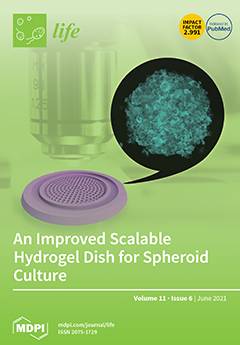Not only iodine deficiency, but also its excess may contribute to thyroid cancer. Potassium iodate (KIO
3), which is broadly used in the salt iodization program, can increase oxidative damage to membrane lipids (lipid peroxidation, LPO) under experimental conditions, with the strongest
[...] Read more.
Not only iodine deficiency, but also its excess may contribute to thyroid cancer. Potassium iodate (KIO
3), which is broadly used in the salt iodization program, can increase oxidative damage to membrane lipids (lipid peroxidation, LPO) under experimental conditions, with the strongest damaging effect at KIO
3 concentration of ~10 mM (corresponding to physiological iodine concentration in the thyroid). Melatonin is an effective antioxidant, which protects against KIO
3-induced LPO in the thyroid. This study aimed to compare the protective effects of melatonin, used in the highest achievable in vitro concentration, against KIO
3-induced oxidative damage to membrane lipids in various porcine tissues (thyroid, ovary, liver, kidney, brain, spleen, and small intestine). Homogenates were incubated in the presence of KIO
3 (20; 15; 10; 7.5; 5.0; 0.0 mM) without/with melatonin (5 mM). The malondialdehyde + 4-hydroxyalkenals (MDA + 4-HDA) concentration (LPO index) was measured spectrophotometrically. KIO
3 increased the LPO in all examined tissues; in the thyroid, the damaging effect of KIO
3 (10; and 7.5 mM) was lower than in other tissues and was not observed for the lowest concentration of 5 mM. Melatonin reduced LPO induced by KIO
3 (10, 7.5, and 5 mM) in all tissues, and in the thyroid it was also protective against as high a concentration of KIO
3 as 15 mM; the LPO level resulting from KIO
3 + melatonin treatment was lower in the thyroid than in other tissues. In conclusion, the thyroid is less sensitive tothe pro-oxidative effects of KIO
3 compared to other tissues. The strongest protective effect of melatonin was observed in the thyroid, but beneficial effects were significant also in other tissues. Melatonin should be considered to avoid the potential damaging effects of iodine compounds applied in iodine prophylaxis.
Full article






